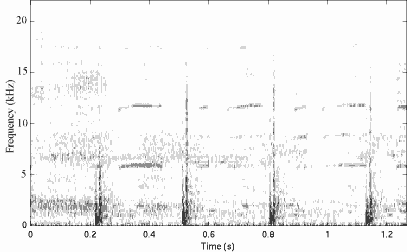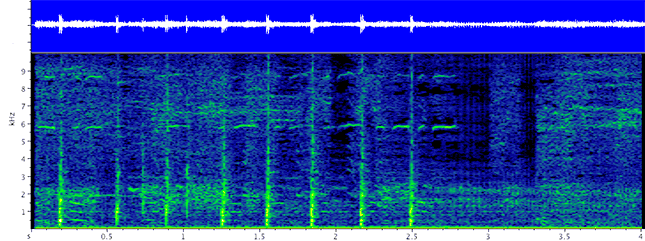Sounds Associated with Aggression
Aggression is a common occurrence in the world of marine mammals. Aggressive displays, or agonistic behavior, are often seen among members of a group or between individuals of different species. Sound can be an important component of agonistic behavior, such as growls as part of a threat display. Animals can listen to these sounds to assess an opponent’s willingness to fight or fighting ability. Loud sounds may also be used to startle or defend against a predator. The best descriptions of aggressive displays come from studies of pinnipeds (e.g. elephant seals) and odontocetes (e.g. Atlantic spotted dolphins, bottlenose dolphins,and beluga whales).
Agonistic behaviors are well described for several species of pinnipeds, including elephant seals and fur seals. Males of some species defend territories, others defend females, while still others establish dominance hierarchies. In these, and other types of aggressive interactions, vocalizations play an important role. Both underwater and in-air sounds may be used, but most currently documented sounds include growls, barks, and grunts in air. However, captive leopard seals were found to produce underwater growls and blast sounds in association with aggressive behaviors such as lunging (with mouth open, teeth exposed) and parallel swimming.
Threat displays are also well documented for cetaceans, such as in Atlantic spotted and bottlenose dolphins. Aggressive displays include open-mouth threats, rapid head nodding, and head-to-head posturing. These species also produce vocal signals, called burst pulse sounds during agonistic interactions. Burst pulsed sounds can have frequency components that extend beyond 100 kHz. Some examples of broadband, burst pulsed sounds produced with aggression have been described as squawks, screams, barks, cracks, and pops.
If an interaction escalates, the vocalizations are often accompanied by increasingly aggressive behaviors such as bubble production, jaw claps, body charges, tail slaps, and other actions. Jaw claps are short, very intense, broadband sounds that are made by opening the mouth and clapping the upper and lower jaws together with force. Tail slaps are made by thrusting the tail out of the water and then slapping it down on the water’s surface. Both of these actions create very abrupt sounds that have a rapid onset and offset. The following waveform and corresponding spectrogram depicts a series of four jaw claps from a captive beluga whales.


The four claps of sound in the spectrogram line up with the four blue pulses in the waveform directly above. The waveform is aligned with the spectrogram in time on the x axis and shows energy, in relative units, on the y axis.
Sound clip provided by Jennifer L. Miksis-Olds. Released under Creative Commons License, non-commercial – no derivs.

Other cetacean species also perform aggressive displays. Male humpback whales, for example, often form competitive groups on the breeding grounds, in which individual males compete with one another for a position next to a female. In these groups, they perform threat displays which include physical posturing and blowing bubble streams, and they also produce a variety of social sounds. These displays provide both visual and acoustic signals of aggression or agitation to other animals within the group.
Additional Links on DOSITS
References
- Au, W. W. L., & Hastings, M. C. (2008). Emission of Social Sounds by Marine Animals. In W. W. L. Au & M. C. Hastings, Principles of Marine Bioacoustics (pp. 401–499). New York, NY: Springer US. https://doi.org/10.1007/978-0-387-78365-9_10
- Blomqvist, C., & Amundin, M. (2004). High-Frequency Burst-Pulse Sounds in Agonistic/Aggressive Interactions in Bottlenose Dolphins, Tursiops truncatus. In Echolocation in Bats and Dolphins (pp. 425–431). Chicago, IL: The University of Chicago Press.
- Helweg, D. A., Bauer, G. B., & Herman, L. M. (1992). Observations of an s-shaped posture in humpback whales (Megaptera novaeangliae). Aquatic Mammals, 18(3), 74–78.
- Herzig, D. (1996). Vocalizations and associated underwater behavior of free-ranging Atlantic spotted dolphins, Stenella frontalis, and bottlenose dolphins, Tursiops truncatus. Aquatic Mammals, 2(22), 61–79.
- Lammers, M. O., Au, W. W. L., Aubauer, R., & Nachtigall, P. E. (2004). A comparative analysis of the pulsed emissions of free-ranging Hawaiian spinner dolphins (Stenella longirostris). In Echolocation in Bats and Dolphins (pp. 414–419). Chicago, IL: The University of Chicago Press.
- Rogers, T. L., Cato, D. H., & Bryden, M. M. (1996). Behavioral significance of underwater vocalizations of captive leopard seals, hydurga leptonyx. Marine Mammal Science, 12(3), 414–427. https://doi.org/10.1111/j.1748-7692.1996.tb00593.x
- Sanvito, F., Miller, E., & Galimberti, F. (2008). Development of aggressive vocalizations in male southern elephant seals (Mirounga leonina): maturation or learning? Behaviour, 145(2), 137–170. https://doi.org/10.1163/156853907783244729
- Silber, G. K. (1986). The relationship of social vocalizations to surface behavior and aggression in the Hawaiian humpback whale ( Megaptera novaeangliae ). Canadian Journal of Zoology, 64(10), 2075–2080. https://doi.org/10.1139/z86-316
- Tripovich, J. S., Canfield, R., Rogers, T. L., & Arnould, J. P. Y. (2008). Characterization of Australian fur seal vocalizations during the breeding season. Marine Mammal Science. https://doi.org/10.1111/j.1748-7692.2008.00229.x
- Tyack, P., & Whitehead, H. (1983). Male Competition in Large Groups of Wintering Humpback Whales. Behaviour, 83(1), 132–154. https://doi.org/10.1163/156853982X00067